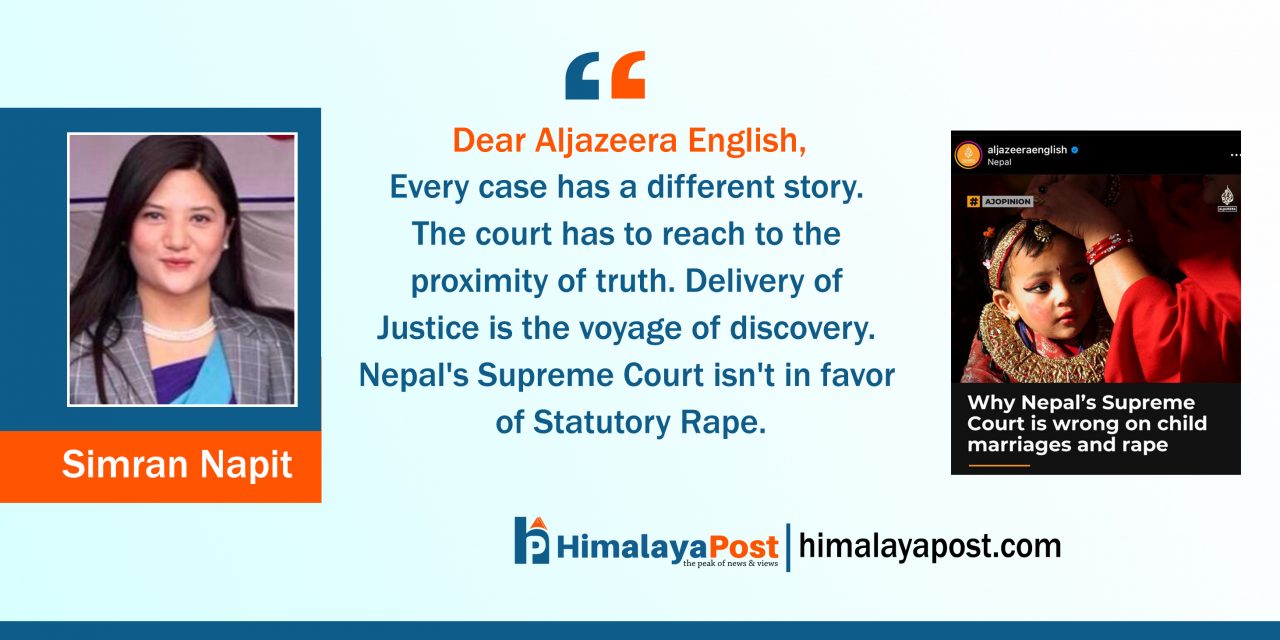– Simran Napit
Dear Aljazeera English,
I saw the article “Why Nepal’s Supreme Court is wrong on child marriages and rape?“I went through the article and ain’t convinced with the opinion written there. The decision has been wrongly interpreted. Meanwhile, I am one of the section officers who assisted concerned Justices to draft the very decision. I think we have the right to defend our interpretation. Primae facie, Nepal’s Supreme Court is always against child marriage and statutory rape.
I think before keeping out the viewpoint, one should definitely read the full text of the decision summarized by me here.
Name of the case: Santosh Kumar Yadav Vs. Nepal Government ( 075-CR-2638)
Case: Kidnapping, abduction and rape
In this case, the accused was charged with the accusations of kidnapping, abduction, and rape as per the National Code ( Muluki Ain) Chapter on Kidnapping and Abduction and Chapter on Rape.
In the charged sheet , F.I.R was launched stating that the accused enticed/allured their daughter with smart phone and he used to come victim’s home when she was all alone and without victim’s consent the accused took her to India and attempted to sell her but with the help of stranger she was able to get back her home.
(FYI: The F.I.R has been launched by the victim’s parents )
Questions Raised before the court:
- Whether the accused should be liable of the counts presented before the court? ( Count Number 1. Kidnapping, Count No. 2 abduction, Count No. 3: Rape)
- Whether the case presented before the court is an Offense under “Chapter of Marriage”?
Court’s Order
First the court visualized the different circumstances and facts revolving the case.
Number 1 , the victim Triyuga Khola( pseudonym) medical report which states : “Hymen Ruptured in 2 oçlock position, 3, 9, 11 oçlock position.
Accused statement before the court:
“As I belong to the lower caste, the victim’s family is always against our marriage. So, without your knowlede , we had to elope. As we eloped, the F.I.R is the result of their anger and caste issues as they never want us to be together.”
Victim too admitted on the love affiar they had and became hostile during court proceeding.
The court prime duty arose as the court has to seek the truth to deliver justice or to seek the proximity of truth. Hereby, justice means to seek the truth . The court cited the case of Riteshh Tiwari and Anr. Vs State of UP and others whereby the justice of India stated that definition of justice as : “Justice: Every trial is voyage of discovery in which truth is quest. “. It is true that in civil case, cases are adjudicated on the basis of “Prepondence of Evidences) . In criminal case. case must be proven beyond the reasonable doubt and benefit of doubt goes to the accused. The prime principle of criminal law is that “It is better that ten guilty people escape though that the innocent shouldnot suffer.”
Hence, in these henious counts presented before the court, one should definitely look upon seriously on the facts and evidences presented before the court. Article 20 of the Constitution of Nepal provisioned on “Right relating to Justice”and Article 21 provisioned on Right relating to Victims of Crime. Article 158 provisioned on the role of prosecutor so as to prosecute with adequate grounds and evidence test. Similarly, Evidence Act 2031 , Section 18 focused on examination of evidences as per the touch stone of admissibility of evidences and the court should trace the admissibility of evidences. Evidences are primarily categorized under two: Admissible and Non-admissible evidences.In this case, Victim gave the hostile statement .
Regarding the “Hostile Victime”, there is an important jurisprudence as it should be visualized very sensitively visualizing different circumstances for the deliverance of hostile statement like :whether the statement is the result of threat, terror, undue- pressure, extortion, or instigation. the context s should be more seriously visualized in the case of minor or differently abled person. Thus, the court can’t only reply upon the hostile statement but should definitely justify hostile statement with surrounding circumstances and further evidences revolving around the case. Evidences should be systematically examined. In this case, the case visualized the important fact that the couple had legally registered their marriage in district court whereby both consented their marriage. This tends to delve on the case more deeply and seriously .
Hereby, even the highest degree of suspicion cannot take place of evidences. In the similar case of S Veradarjan Vs. State of Madras the court stated that “A girl who was on the verge of attaining majority voluntarily left her father’s house , arranged to meet the accused at a certain place and went to the sub- registrar’s office, where the accused and the girl registered an agreement to marry, there was no evidence whatever the accused had taken her out of the lawful guardianship of her parent, there was no active part played by the accused to persuade her to leave the house. It was held that no offense under this section was made out.” There are numerous instances of child marriage even in U.S and the country has affixed the age of marriage as per the important circumstances. In some states, children can legally marry at younger age they can legally consent to sex. Some states explicitly exempt sex between married persons from their statutory rape laws, as in Louisiana Stae of U.S.The states included in our analysis, 33 states and District of Columbia explicitly exempt sex between married person from prosecution under some or all statutory rape cases.
Some tend to attain their puberty at early age and tend to do sexual intercourse in early age. Close-in – age exemption and Romeo and Juliet law should also be clearly visualized in this perspective. Regarding the very case, the proximity truth that the marriage- registration certificate and the couple having a daughter as well as the victim living with the accused (victim’s husband) and her in-laws , clearly suggest that the marriage was mutual and the counts on kidnapping , abduction and rape can’t be proven . Hence, the court charged the accused under the chapter of marriage and criminalize child marriage. Adhereing the principle “culpae poena par esto”: The punishment prescribed for a crime should be proportional to the seriousness of the crime”and just desert principle “The philosophy of fair and appropriate punishment that is related to the severity of the crime was committed.” Hence, the justice prevailed.
Maxim:
Every case has a different story. The court has to reach to the proximity of truth . Delivery of Justice is the voyage of discovery. Nepal’s Supreme Court isn’t in favor of Statutory Rape.
(Ms. Napit is the Section officer at Supreme Court of Nepal.)





